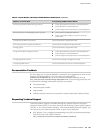
The J4350 Services Router supports the following field-replaceable PIMs and Avaya
VoIP modules:
■ Gigabit Ethernet uPIM (1-port, 6-port, 8-port, and 16-port)
■ SFP Gigabit Ethernet ePIM (1 port)
■ Copper Gigabit Ethernet ePIM (1 port)
■ Dual-Port Serial PIM
■ Dual-Port E1 PIM
■ Dual-Port T1 PIM
■ Dual-Port Channelized T1/E1/ISDN PRI PIM
■ E3 PIM (1 port)
■ DS3 (T3) PIM (1 port)
■ Dual-Port Fast Ethernet PIM
■ 4-port Fast Ethernet ePIM
■ 4-port ISDN BRI S/T or U PIM
■ ADSL 2/2+ Annex A PIM (1 port)
■ ADSL 2/2+ Annex B PIM (1 port)
■ G.SHDSL PIM (2 ports)
■ TGM550 Telephony Gateway Module
■ TIM508 Analog Telephony Interface Module (8 ports)
■ TIM510 E1/T1 Telephony Interface Module (1 port)
■ TIM514 Analog Telephony Interface Module (4 ports)
■ TIM516 Analog Telephony Interface Module (16 ports)
■ TIM518 Analog Telephony Interface Module (16 ports)
■ TIM521 ISDN BRI Telephony Interface Module (4 ports)
J6350 Services Router Overview
The J6350 Services Router is designed primarily for regional or central offices. It has
a chassis that is 2 U (rack units) in size with an optional redundant AC or DC power
supply, up to 2 GB of memory, and two universal serial bus (USB) ports for external
storage. The J6350 Services Router is a higher-performance system than the J4350
Services Router.
J6350 routers come standard with 1 GB of memory and can be upgraded to 2 GB of
memory. For instructions on adding memory, see “Replacing DRAM
Modules” on page 188.
Each J6350 chassis contains four built-in Gigabit Ethernet ports with link speeds of
10/100/1000 Mbps over a copper interface, and six slots for field-replaceable Physical
Interface Modules (PIMs) and Avaya VoIP modules. Four of the six slots (slots 2, 3,
5, and 6) support high-speed interfaces (ePIMs).
6 ■ J6350 Services Router Overview
J2320, J2350, J4350, and J6350 Services Router Getting Started Guide


















